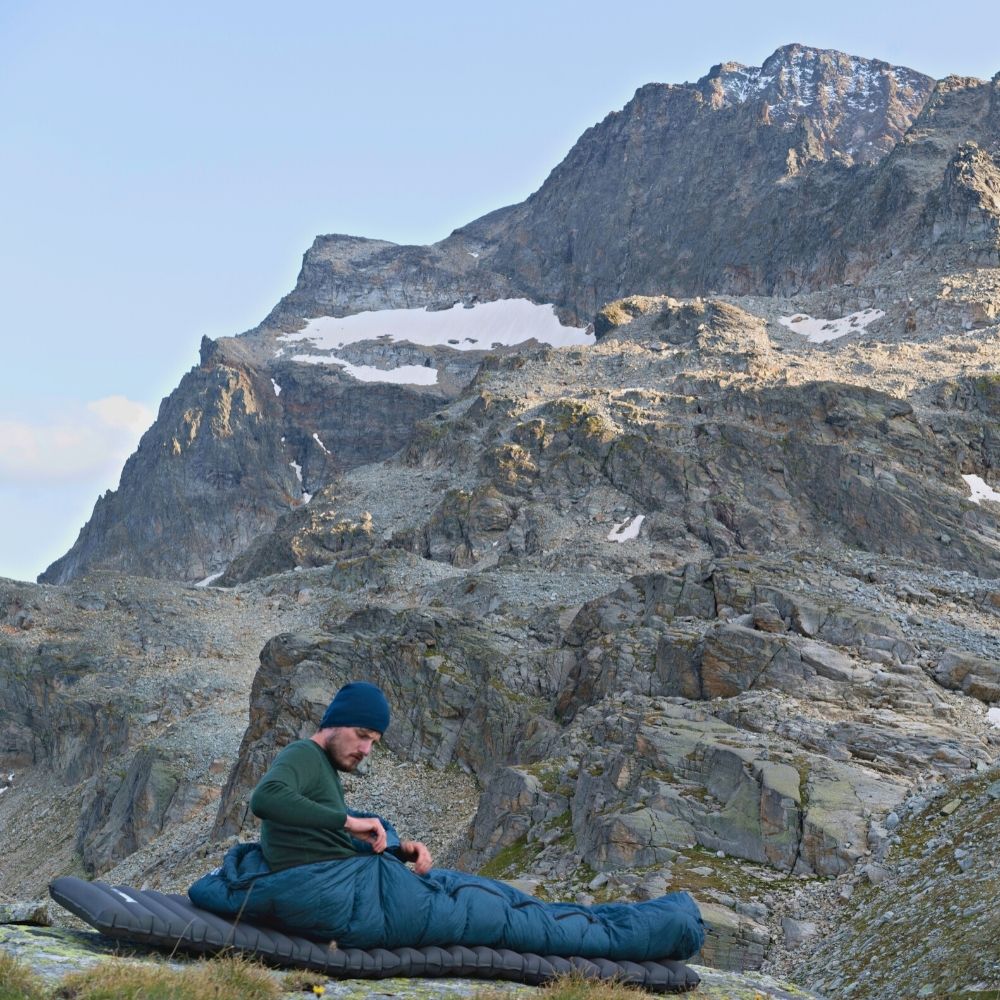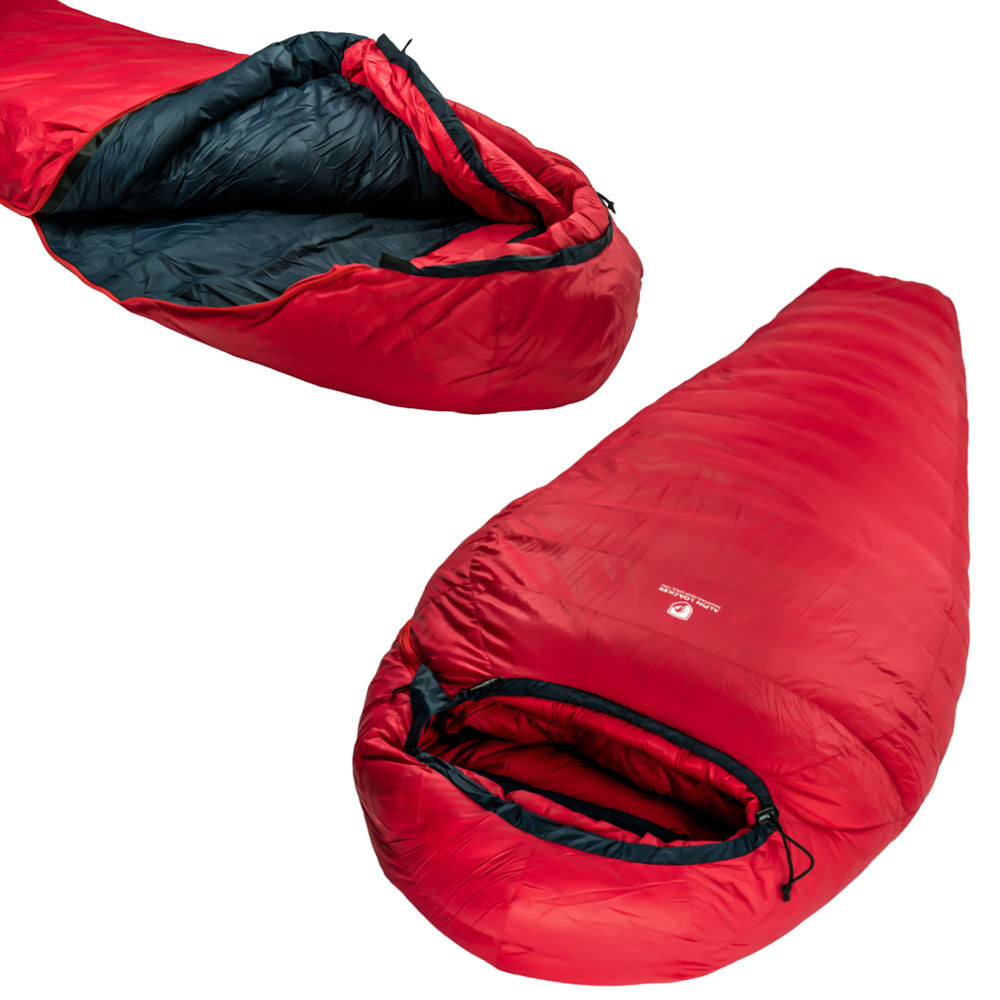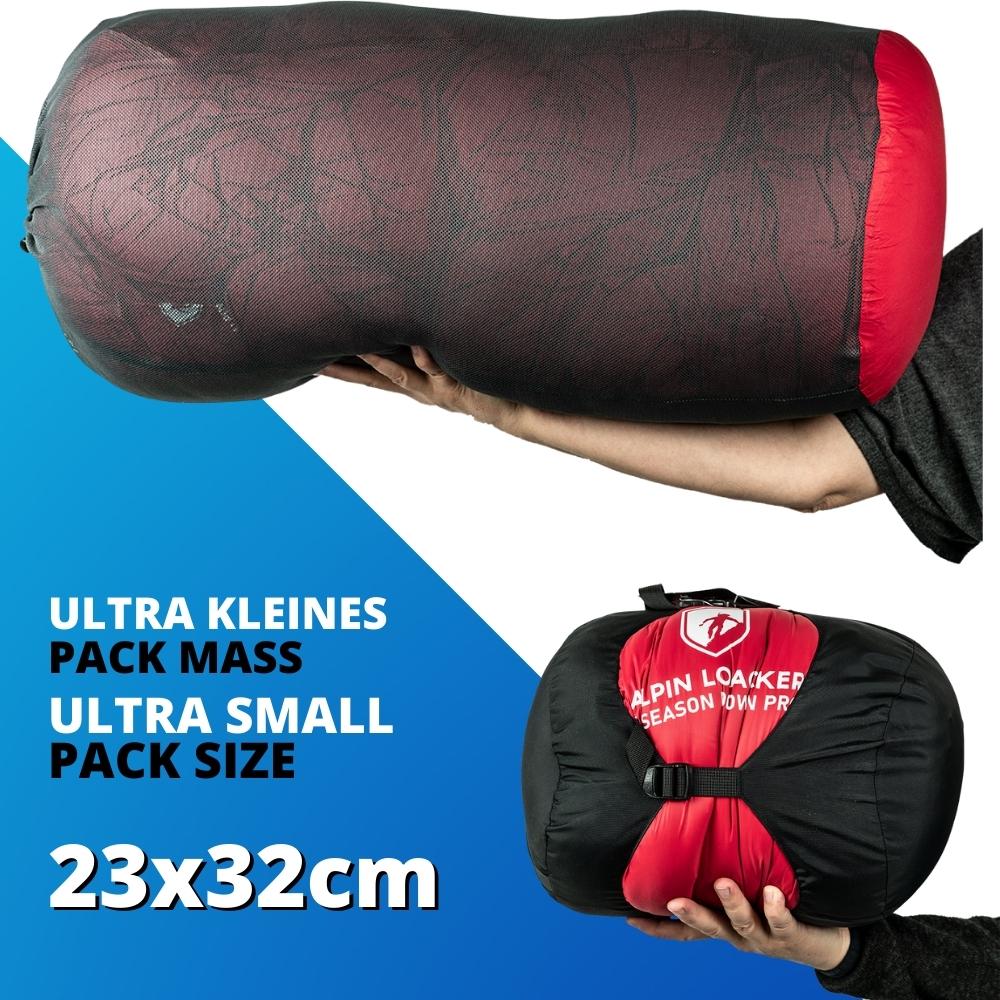Ist ein 4 Jahreszeiten Schlafsack ein Winterschlafsack?
Ein 4 Jahreszeiten Schlafsack wird im Sommer hauptsächlich in höheren Regionen verwendet bzw. Gebieten, in denen die Temperaturen auch im Sommer stark fallen können. Im Sommer kann die Temperatur auch in höheren Bergregionen unter 0 sinken. Wenn Du im Sommer auf einem Gletscher übernachtest und Eis unter dir hast, wird die Frage nach welchem Schlafsack hinfällig - damit Du bei diesem Abenteuer nicht frieren musst, brauchst du unbedingt einen warmen 4 Jahreszeiten Schlafsack und vorallem eine gute Isolierung von unten - sprich Isomatte.
Die Antwort auf die Frage ist also Ja und Nein!
Manche Hersteller sprechen auch von einem 5-Season Schlafsack. Dahinter befindet sich aber dasselbe Modell wie bei einem 4-Jahreszeiten-Schlafsack.
Was bedeutet 4 Jahreszeiten Schlafsack?
Unter bestimmten Bedingungen ist ein 4-Jahreszeiten-Schlafsack für den Einsatz das ganze Jahr hindurch geeignet.
Ein ganzjahres Schlafsack muss vor allem auch im Winter verwendbar sein. Das bedeutet,
seine Isolation muss Temperaturen von -17 °C bis +4°C abdecken können. Sprich - die Komforttemperatur sollte etwa bei -10 °C liegen. Was man unter Komforttemperatur versteht, kannst Du in unserem Blogbeitrag: “Winterschlafsack für den Outdoorbereich, Hilfestellung fürs Schlafsack kaufen” nachlesen.

Der 4 Jahreszeiten Schlafsack ist, wie der Name schon sagt, für das ganze Jahr - unter bestimmten Bedingungen, anwendbar.
Wie lang sollte der Reißverschluss eines 4-Jahres Schlafsackes sein?
Der 4-Jahreszeiten-Schlafsack benötigt sowohl eine sehr gute Isolation als auch eine ausreichende Belüftung, damit es in wärmeren Nächten nicht zu warm wird. Der Zip des Schlafsacks sollte also bis möglichst ¾ der Schlafsacklänge oder besser noch länger öffnungsfähig sein.

Der Zip des Schlafsacks sollte bis möglichst ¾ der Schlafsacklänge öffnungsfähig sein.
Was ist noch wichtig beim Kauf eines 4 Jahreszeiten Schlafsack?
Neben der Temperaturangabe lohnt es sich, Zeit in die Auswahl der richtigen Größe und Form zu investieren. Die bekannteste und häufigste Form für ganzjahres Schlafsäcke ist der Mumienschlafsack. Er ist von oben bis unten körpernah geschnitten und hat eine Kapuze. Manche Modelle verfügen zusätzlich über einen Halswärmer. Durch den eng anliegenden Schnitt am Körper speichert dieser Schlafsack die Körperwärme im Vergleich zu anderen Schlafsack Arten am effizientesten und hat zudem ein kleines Packmaß.
Weitere Details, auf die Du beim Kauf achten solltest, sind beispielsweise die Kammernkonstruktion, die Qualität und Herkunft der Daune und die Frage, ob das Außenmaterial wasserabweisend und/oder winddicht ist.
Falls Dein Schlafsack koppelbar ist, kannst Du ihn an den Deines Partners anzippen und ihr könnt zu zweit darin schlafen.

Kapuze und Kragen sind unerläßlich für einen 4-Jahreszeiten Schlafsack.
Wichtig: Der dickste und isolationsfähigste Schlafsack funktioniert nur dann, wenn Du eine gut isolierende Unterlage hast. Die meiste Wärme wird nämlich über den Boden verloren.
Richtlinien und Merkmale guter 4-Jahreszeiten-Schlafsäcke
- Ein Schlafsack für vier Jahreszeiten muss Temperaturen von ca. +4 °C bis ca. -16 °C abdecken können.
- Die Form ist dem Körper angepasst: Mumienschlafsäcke oder Eiform-Schlafsäcke.
- Kunstfaserschlafsäcke sind für nasse und feuchte Klimazonen.
- Geringes Gewicht
- Daune ist für trockene Kälte/Regionen und hat ein kleineres Packmaß.
- Achte auf die Bezeichnung 4 Jahreszeiten Schlafsack oder 5 Jahreszeiten Schlafsack.
- Geringes Packmaß (Komprimierung)
- Leicht zu bedienen
- Verschiedene Größen: Wähle eine Schlafsacklänge entsprechend Deiner Größe aus.
- Robustes Obermaterial
- Nachhaltige bzw. recycelte Daune

Dieser Schlafsack hat ein sehr geringes Packmaß. Daunen lassen sich sehr gut komprimieren und erzielen dadurch noch ein geringeres Packmaß.
Ähnliche Blog Beiträge

Winterschlafsack für den Outdoorbereich
Wenn Du auch in der kalten Jahreszeit nicht auf Outdoor Abenteuer verzichten möchtest, benötigst Du einen hochwertigen Winterschlafsack. Er schützt Dich zuverlässig vor Kälte und sorgt für erholsamen Schlaf.
- Doch woran kannst Du einen guten Outdoor Schlafsack für extreme Temperaturen erkennen?
- Reicht vielleicht schon Dein vorhandenes Modell?
All das und noch viel mehr erfährst Du im folgenden Blogbeitrag. Wir zeigen Dir, worauf Du beim Kauf achten solltest, klären Dich über Materialien und Temperaturbereiche auf und zeigen Dir wichtige Lifehacks. Klingt spannend? Ist es auch! Also nichts, wie los.
Wann benötige ich einen Winterschlafsack?
Ein warmer Schlafsack im Winter ist ein absolutes Must-have. So viel ist sicher. Doch in welchen Situationen benötigst Du ihn eigentlich noch?
- Kalter Winter im Flachland
- Alle Jahreszeiten im Gebirge (hier kann es auch im Sommer empfindlich kalt werden)
- Bei Übernachtungen in unbeheizten Hütten
- Wenn Du generell schnell frierst, leicht erschöpfst
- Wenn Du an einer Schilddrüsenunterfunktion leidest
- Auch extrem leichtgewichtige Menschen nutzen einen Daunenschlafsack nicht nur im Winter

Worauf kommt es bei der Anschaffung eines Winterschlafsacks an?
Damit Dir Dein Outdoor Schlafsack im Winter gute Dienste leistet, solltest Du vor dem Kauf folgende Kriterien beachten:
-
Größe: Ein Winterschlafsack für Herren und Damen sollte weder zu groß noch zu klein gewählt werden. Wichtig ist, dass Du Dich bequem ausstrecken kannst. Achte jedoch darauf, dass nicht zu viel „Luft“ an den Seiten ist, um die Wärmeleistung nicht zu gefährden.
-
Form: Aus diesem Grund solltest Du auch auf die Form achten. Ein Mumienschlafsack ist körpernah geschnitten. Dadurch bietet er Dir eine wesentlich bessere Isolationsleistung als die Eiform oder rechteckige Deckenschlafsäcke.
-
Packmaß: Auch das Packmaß ist entscheidend. Das ist einer der Gründe, warum ein Daunenschlafsack für den Winter besser geeignet ist als andere Modelle. Du kannst ihn aufgrund des geringen Packmaßes leichter im Rucksack transportieren.
-
Gewicht: Gleiches gilt auch für das Gewicht. Aufgrund der verwendeten Daunenfüllung bringen diese Modelle weniger Gewicht auf die Waage. Unser Down Pro 4 Jahreszeiten Daunenschlafsack bringt in der 170 cm Version gerade einmal 1520 g auf die Waage. Somit lässt sich der Winterschlafsack für Herren und Damen besonders leicht transportieren.
-
Material: Kunstfaserschlafsäcke sind zwar aufgrund der verwendeten Materialien besonders pflegeleicht und schnell trocknend. Allerdings ist ihre Wärmeleistung sehr gering. Deshalb empfehlen wir Dir einen Daunenschlafsack für den Winter.
Unser 4 Jahreszeiten Daunenschlafsack ist nicht nur mollig warm, sondern auch atmungsaktiv und 100 % schadstofffrei. Das Außenmaterial aus 20 D Ripstop Nylon ist, genau wie die nachhaltige Daunenfüllung, absolut umwelt- und hautfreundlich. So kannst Du den Schlafkomfort genießen, den Du verdienst: den Besten.
- Kosten: Gerade in der heutigen Zeit spielt der Kostenfaktor natürlich eine wichtige Rolle. Kunstfaserschlafsäcke sind natürlich günstiger als ein Naturprodukt wie Daune. Doch bedenke stets: Ein warmer Schlafsack im Winter ist wichtiger als anderes Equipment. Zumal Du einen hochwertigen Daunenschlafsack bei guter Pflege jahrelang verwenden kannst.
Somit relativieren sich die Anschaffungskosten gewaltig. Denn während günstigere Modelle oftmals nach der zweiten Saison extreme Wärmeeinbußen verzeichnen, hält Dich unser Down Pro 4 Jahrelang mollig warm.
Was bedeutet der Temperaturbereich bei Schlafsäcken?
Es gibt bis zu drei unterschiedliche Temperaturangaben, die Du auf dem Schlafsack findest:
1. Komforttemperatur:
Dieser Wert wird für eine »Norm-Frau« (25 Jahre, 60 kg, 1,60 m) berechnet, die gerade noch nicht friert. Als Beispiel: In einem Schlafsack mit Komforttemperatur 0° kann noch komfortabel geschlafen werden, ohne zu frieren.
2. Grenztemperatur:
Dieser Wert zeigt die Temperatur, bei der ein »Standard-Mann« (25 Jahre, 70 kg, 1,73 m) im Schlafsack nicht friert.
3. Temperaturbereich nach Jahreszeit:
- Sommerschlafsäcke: Komforttemperatur oberhalb von 12 °C
- Drei-Jahreszeiten-Schlafsäcke: Komforttemperatur bis 0 °C
- Winterschlafsäcke: Komforttemperatur unter 0 °C
Sind Winterschlafsäcke automatisch schwerer als andere Modelle?
“Jein”. Das hängt stark von den verarbeiteten Materialien ab. Schlafsäcke sind nämlich entweder mit einer Kunstfaser oder mit Daunen gefüllt.
Eine Daune ist eine kleine zarte Feder mit weichem Kiel und sehr weichen und langen, angeordneten Feder-Ästchen. Sie befinden sich unter den Deckfedern der Vögel. Daunen sind wesentlich leichter als Kunstfasern und wärmen im Verhältnis besser als Kunstfasern.
Kunstfaser benötigt nämlich viel zusätzliches Material, um auf dieselbe Komfortbereich-Temperatur zu kommen wie Daunen.
Dies bedeutet, dass ein Schlafsack, der mit Kunstfaser gefüllt ist, immer schwerer wird, um die gleichen isolierenden Eigenschaften zu erreichen. Somit ist ein Daunenschlafsack im Winter oftmals besser geeignet.

Warum ist ein Daunenschlafsack am besten für den Winter?
Wie Du weißt, haben Daunen eine besondere Fähigkeit. Sie schenken Dir trotz ihres geringen Gewichts perfekte Wärme. Deshalb eignen sie sich hervorragend zur thermischen Isolierung im Winterschlafsack für Herren und Damen.
Hochwertige Gänse- und Entendaunen sorgen für die beste Wärmeisolation im Verhältnis zu Volumen und Gewicht. Die weiche Füllung ist sehr leicht, anschmiegsam und stark komprimierbar.
Wie Du bereits gesehen hast, ergeben sich daraus folgende Vorteile:
- Daunenschlafsäcke sind bei gleicher Isolationsleistung im Vergleich zu Kunstfaserschlafsäcken nicht nur leichter.
- Sie sind auch stärker komprimierbar und verfügen dadurch über ein geringeres Packmaß.
Es gilt die Regel:
Wenn Wärme, Gewicht und Packmaß eine Rolle spielen, solltest Du ausschließlich auf Daunenschlafsäcke zurückgreifen.
Das Schlafklima im Daunenschlafsack ist wesentlich angenehmer, weil die flauschigen Federchen sehr atmungsaktiv sind und auch exzellent Körperfeuchtigkeit aufnehmen können. Der einzige Nachteil der Daune ist, dass sie ihre isolierende Wirkung verliert, wenn sie nass wird. Die Daune fällt zusammen und klumpt.
Wenn Du Deinen Daunenschlafsack im Winter bei Minustemperaturen verwendest, musst Du Dir darüber jedoch keine Gedanken machen. Daunen Schlafsäcke solltest Du übrigens prinzipiell nicht bei Regen ohne Unterschlupf verwenden. Dasselbe gilt bei starker Taubildung.
Vielleicht fragst Du Dich, wie Du Klumpenbildung generell vermeiden kannst.
Expertentipp: Schüttle Deinen Outdoor Schlafsack im Winter und jeder anderen Jahreszeit nach dem Aufstehen kräftig aus und lasse in am besten in der Sonne hängend trocknen. Sollte weit und breit kein Sonnenstrahl in Sicht sein, wähle einfach einen trockenen Ort.
Special - Schlafsack Vergleich:
Alpin Loacker Down Pro 4 Jahreszeiten Daunenschlafsack & Deuter Astro Pro 1000 Daunenschlafsack
| Eigenschaften | ALPIN LOACKER Down Pro 4 | Deuter Astro Pro 1000 |
| Spezifikationen | -10°C | -12°C |
| Komforttemperatur | -15°C | -21°C |
| Jahreszeit | 4 Jahreszeiten Schlafsack | 4 Jahreszeiten Schlafsack |
| Gewicht ohne Aufbewahrung | 1620 g (195 cm Version) L |
1500 g (185 cm |
| Einsatzbereich | Trekking, Hochtouren | Trekking, Hochtouren |
| Materialeigenschaften | wasserabweisend | wasserabweisend |
| Mischungsverhältnis | 90/10 Daune/Federn | 90/10 Daune/Federn |
| Bauschkraft | 750 cuin | 650+ cuin |
| Füllmaterial | weiße Entendaune 1000 g RDS (Responsible Down Standard) | graue Entendaune 1000 g |
| Packmaß | ø 23cm x 32cm | ø 23cm x 42cm |
| PFC free* | ja | ja |
| Hauptmaterial | 100 % recyceltes 20D Ripstop Nylon (PA) | 20 D Ripstop PA (Polyamid) |
| Featueres | wasserabweisende Daune DowntekTM PFC frei Hydrophobe Daunen, so dass der Schlafsack auch bei Nässe noch warm ist | wasserabweisende Daune DWR Durable Water Repellency PFC frei |
| Geeignet für | unisex | unisex |
| Konstruktion | Mumienschlafsack | Mumienschlafsack |
| Extras | einstellbare Kapuze (Kapuzen Design genau an den Kopf angepasst) Kompressionssack, Aufbewahrungsnetz (bei längerem Nicht-Gebraucht) | Wärmekragen, einstellbare Kapuze, Kompressionssack, Innentasche, 3D-Fußbox, inkl. Packsack |
| Zertifikate | Responsible Down Standard |
Certified Animal Welfare Grüner Knopf Bluesign® Product |
*PFC – Was sind PFC?
PFC ist eine Abkürzung für per- und polyfluorierte Chemikalien, – auch bekannt als PFAS (per- und polyfluorierte Alkylsubstanzen) oder PFT (perfluorierte Tenside).
Diese Stoffgruppe umfasst mehr als 3000 verschiedene Stoffe. PFC kommen nicht natürlich vor. Chemisch gesehen bestehen die organischen Verbindungen aus Kohlenstoffketten verschiedener Längen, bei denen die Wasserstoffatome vollständig (perfluoriert) oder teilweise (polyfluoriert) durch Fluoratome ersetzt sind.
PFC sind kaum abbaubar und verbleiben daher für einen sehr langen Zeitraum in der Umwelt. Einige PFC reichern sich in der Umwelt und in Organismen an und wirken zudem gesundheitsschädlich auf den Menschen.
Fazit
An welchen Kriterien solltest Du Dich nun beim Kauf Deines idealen Schlafsacks orientieren? Im Prinzip ist es Simpel: Der Schlafsack, der mit einer Komforttemperatur von null Grad das kleinere Packmaß und das geringere Gewicht aufweist, ist der „Bessere".
Wenn er dazu noch ein robustes und wasserabweisendes Ripstop-Nylon besitzt, liegst Du auf der sicheren Seite.
Kennst Du schon die wichtigsten Pflegehinweise für Daunenschlafsäcke? Diese findest Du in unserem Blogbeitrag: Daunenschlafsack waschen » Tipps & Step-by-Step Anleitung
FAQ
Worauf muss ich beim Waschen eines Winterschlafsacks achten?
Keine Frage: ein warmer Schlafsack im Winter in Gold wert. Damit Du lange Freude daran hast, darfst Du Deinen Daunenschlafsack so wenig wie möglich waschen. Falls er dennoch eine Wäsche nötig hat, solltest Du ihn zunächst auf Beschädigungen untersuchen.
Bei Löchern und Rissen solltest Du einen Winterschlafsack für Herren und Damen nicht waschen, sondern zuerst fachkundig reparieren lassen. Sind keine Schäden erkennbar, schließt Du nach der sorgfältigen Prüfung alle Verschlüsse (bis auf eventuelle Schnürungen) und drehst Deinen Winterschlafsack auf Links.
Ein Daunenschlafsack darf keinesfalls (!) in der Waschmaschine gewaschen werden. Hier verklumpen die Daunen und bieten keinerlei Wärmeleistung mehr.
Weiche Deinen Winterschlafsack für Erwachsene (und Kinder) stattdessen lieber in handwarmem Wasser mit etwas Fein- oder Funktionswaschmittel ein. Dazu eignet sich die Badewanne oder eine große Schüssel.
Spüle ihn anschließend unter fließendem Wasser aus und lege ihn zum Trocknen aus. Verzichte bitte auf Auswringen und dergleichen. Drücke das Wasser lieber vorsichtig heraus, um die Daunen nicht zu beschädigen.
Gibt es spezielle Kinderschlafsäcke für den Winter?
Ja, es gibt nicht nur den passenden Winterschlafsack für Erwachsene, sondern auch für Kinder.
Welche Kleidung trägt man in einem Winterschlafsack?
Um die Wärmeleistung deines Outdoor Schlafsacks im Winter zu optimieren, solltest Du ausschließlich temperaturausgleichende Kleidung verwenden. Baumwolle und Synthetik scheiden dabei gänzlich aus.
Unsere Erfahrung hat gezeigt, dass Du in Merino Kleidung optimalen Schlafkomfort genießt. Die Naturfaser bietet Dir mit ihrer Thermoregulationsfähigkeit eine ausgezeichnete Wärmeleistung. Außerdem ist sie geruchsneutral, atmungsaktiv und kratz nicht.








